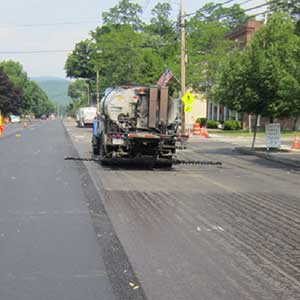Bitumen emulsion has a vital role towards construction, rehabilitation and maintenance of roads. Emulsions used for road work are cationic slow setting emulsion-1 (CSS1), cationic slow setting emulsion-1h (CSS1h), anionic slow setting bitumen emulsion (SS1) & anionic slow setting bitumen emulsion (SS1h) as per the requirement of the project.
1.0
Prime Coat with Cationic Bitumen Emulsion:
It is an application of low viscous bitumen over a granular base like GSB and WMM, developing it for laying an asphalt mix like dense bituminous macadam on it. The bituminous emulsion material to be used as prime coat shall be such that it can penetrate about ten millimetres deep into the base course.
Prime coat applied with Cationic bitumen emulsion of approved grade conforming to IS 8887-1978 and requisite quantity on the prepared surface of the granular base including cleaning of the road surface and spraying primer using mechanical means completed as per Clause 502 of Specifications for Road & Bridge Works of MORTH (5th Revision). Where DBM is to be laid over WMM surface, Prime coat shall be applied over the granular surface before laying of DBM, and the rate of application shall be as per BOQ and methodology approved by Engineer.
Rate of Spray as per MORTH(5th Revision):
| Type of Surface | Rate of Spray (kg/sq.m) |
| WMM/WBM | 0.7–1.0 |
| Mechanically lime/cement stabilized soil bases, lime cement bases | 0.9–1.2 |
| Gravel bases, Crusher run Macadam and crushed rock bases | 1.2–1.5 |
1.1
Weather & Seasonal limitation of Cationic Bitumen Emulsion:
The cationic bituminous emulsion primer shall not be applied on a wet surface or during dirt storm or when the weather is rainy foggy or windy. The prime coat for surface treatment should not be applied when the temperature in the shade is less than ten degrees.
1.2
Construction Operations of Prime Coat using Cationic Bitumen Emulsion:
1.2.1
Equipment for Prime coat:
The primer distributor shall be pneumatic tyred self-propelled pressure distributor equipped for spraying the cationic bitumen emulsion uniformly at specified rate and temperature.
1.2.2
Preparation of Surface for prime coat:
The bed to be primed shall be swept clean, free from dust and shall be dry. It shall be shaped to the specified grades and section. It shall be free from ruts and, any other irregularities and segregated materials.
1.2.3
Application of Cationic Bitumen Emulsion for primer:
- The surface of the base should be well swept with a mechanical broom
- The dust if any on the surface to be blown with an Air Compressor
- Moistening of the surface to be done immediately prior to primer to assist the primer in wetting the surface uniformly and facilitates its penetration into the base. Care should be taken however not to apply on the excess of water since voids.
- The bituminous primer shall be sprayed/distributed uniformly at the rate of 6.0 to 9.0 kg/Sqm over the dry surface using self – propelled sprayer equipped with self-heating arrangement, suitable pump, adequate capacity compressor and spraying bar with nozzles having constant volume or pressure system capable of supplying primer at a specified rate and temperature to provide a uniformly unbroken spread of primer
- Before spraying primer the calibration of the primer sprayer to be conducted on the trial stretch to determine the speed of the sprayer and ht of the nozzle bar to as to spray the required rate of primer
- Spraying temperature shall be between 30 to 55 degree
- The temperature of application of a primer need only be high enough to permit the primer to be effectively sprayed through the jets of the spray bar and to cover the granular base surface uniformly in the desired quantity
- Tray test shall be conducted to determine the rate of spread of binder.
Also, Read: Asphalt Concrete/Bituminous Concrete(BC) Construction Guide
1.3
Quality Control and Test Frequency for Prime Coat (Cationic Bitumen Emulsion):
| Type of Construction | Test | Frequency |
| Primer | 1. Quality of Binder. | Two samples per lot |
| 2. Binder temperature for application | At regular close interval | |
| 3. Rate of spread of binder. | Two test per day |
1.4
Curing of primer:
After applying cationic bitumen emulsion primer, the surface shall be allowed to cure for at least 24hours so as to allow penetration into the base course and aeration of volatile from the primer material. It shall always be ensured that while open to any traffic, the primed surface is fully cured and is not sticky to avoid being picked up by traffic.
2.0
Tack Coat with Cationic Bitumen Emulsion:
“Tack Coat” is a very thin application of diluted bitumen emulsion. It is used to assure a bond between a paved surface and the new course.
Tack Coat applied with Cationic Bitumen Emulsion of approved grade conforming to IS: 8887-1978 on the prepared surface cleaned with Hydraulic broom, moistening the surface completed as per Clause 503 of Specifications for Road & Bridge Works of MORTH (5th Revision). On Cement concrete pavement using Bitumen emulsion @ 0.3 kg per sqm shall be used. The tack coat shall be applied over the previously primed surface or even previously laid Bitumen surface before laying of DBM, and the rate of application shall be as per BOQ and methodology approved by Engineer.
2.1
Construction Operations of Tack Coat using Cationic Bitumen Emulsion:
- The surface of the bed on which the tack coat is to be applied shall be wiped off the dust and any extraneous material by using mechanical boomer
- First dust shall be removed from the bed surface with the help of a compressor.
- Binder material inside the sprayer is heated to a temperature of 50 to 80 degree.
- Once the temperature is attained the binder shall be applied uniformly with the aid of either self tyred propelled bituminous pressure with self-testing arrangement and spraying bar with nozzles having constant volume & pressure system, capable of spraying bituminous of 2.5 to 3.0 kg/10Sqm on the primed surface and 2.0-2.5 kg/10Sqm on the bituminous surface so as to provide a uniformly unbroken spread of bituminous
- The applied tack coat shall be allowed to cure without being disturbed until the cutter has been completely evaporated.
2.2
Quality Control and Test Frequency for Tack Coat (Cationic Bitumen Emulsion):
| Type of Construction | Test | Frequency |
| Tack Coat | 1. Quality of Binder. | Two samples per lot |
| 2. Binder temperature for application | At regular close interval | |
| 3. Rate of spread of binder. | Two test per day |






I appreciate your effort in sharing this great information, thanks.